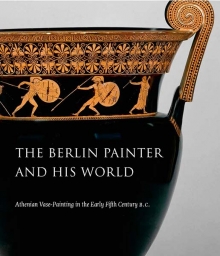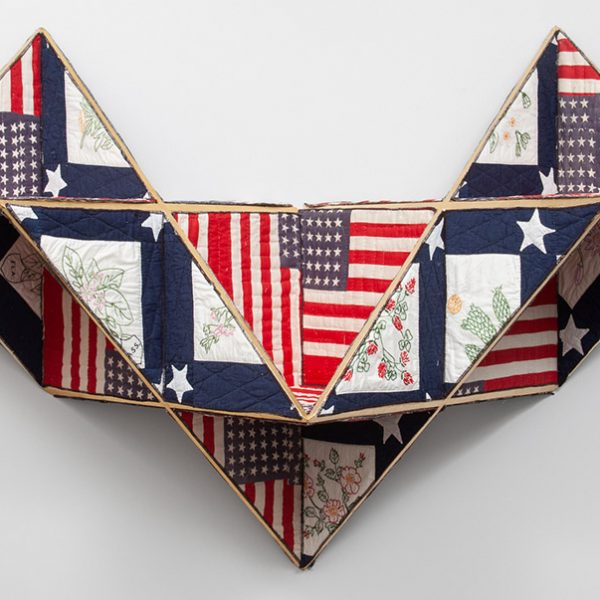Immortal Oracle: the Berlin Painter Speaks: An Interview with J. Michael Padgett by David Ebony
David Ebony —
In dark times of social turmoil, political upset, and the seemingly perpetual war and violence that define our present era, it helps to consider the art of the far distant past for some solace, and a bit of elucidation, perhaps. Today, democracy seems as fragile as it was in its nascent times in ancient Greece. The years of its development, from the Archaic Period to the Golden Age of the fifth century B.C., was far from placid, however. Despite the Athenians’ constant wars with Persia, and domestic unrest, the foundation of democracy, and what would become Western civilization, was firmly established, and philosophy, science, poetry and art flourished.
Though the ancient Greeks had a long tradition of painting, most examples on murals and panels have been lost. Today, one can gauge their unparalleled achievements in painting primarily by means of the many examples of black-figure and red-figure vase painting that have survived the centuries. Many of these decorated vases, pots, and cups are completely intact as they were prized artifacts buried with individuals in their tombs, and uncovered millennia later. The early, black-figure technique features black figures set against red clay grounds. By about 530 B.C., the red-figure technique gained prominence—a reversed process in which the background is coated with black slip, and the figures are left “reserved” in red.
In the early 1900s, British scholar John D. Beazley (1885-1970), and other experts, began to catalogue and identify individual Greek vase painters based on stylistic attributes recurring on numerous vessels. Though few of the artists signed their works, many were discovered and identified through these pioneering studies. Widely regarded as one of the most accomplished artists of the fifth-century B.C., the Berlin Painter (named after a large amphora in the collection of the Berlin State Museums), is known for his exquisite draftsmanship. His distinctive style features a crisp, elegant line, consistently graceful arrangements of figures, and a clarity of vision that are the hallmarks of Classical art. Today, the Berlin Painter’s vision seems fresh and lively, conjuring the distant past and, at least for some, portending a hopeful future.
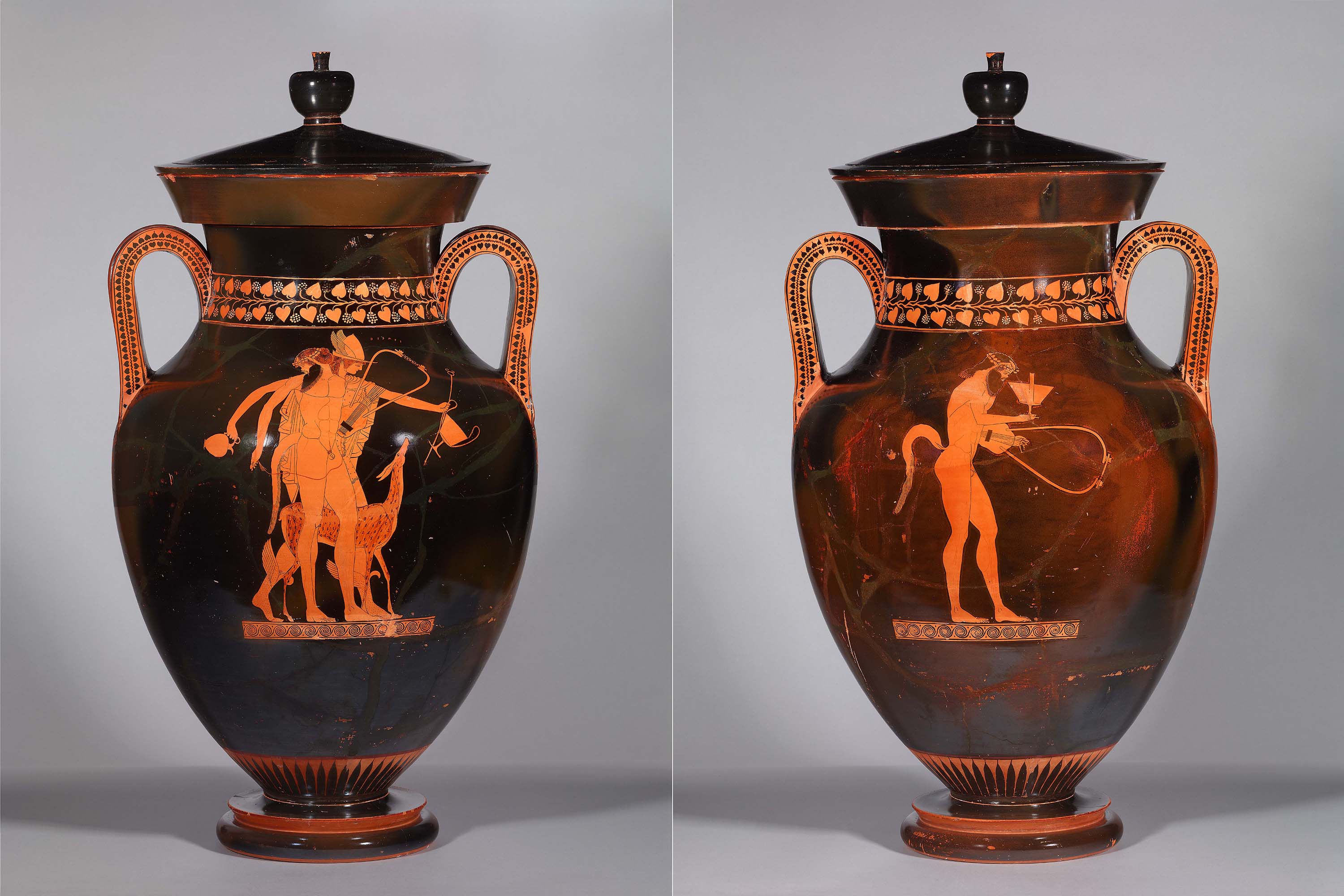
Left: Satyr and Hermes; Right: Satyr; Two views of Red-figure Amphora of Type A; Greek, Attic, ca. 500-490 B.C., attributed to the Berlin Painter; Found at Vulci, Italy, 1834.
There is almost no biographical information for the Berlin Painter, except that he lived in Athens. Even the artist’s gender is uncertain, although conventions of the time would indicate that he was male. We do know that the Berlin Painter was prolific. More than 300 of his works have survived. It is surprising then that, until now, there has never been a major museum show devoted to his work. A unique exhibition currently on view at the Princeton University Art Museum, The Berlin Painter and His World: Athenian Vase-Painting in the Early Fifth Century B.C., is the first comprehensive survey devoted to one who is widely regarded as among antiquity’s great artists. The accompanying catalogue, featuring a catalogue raisonné of the Berlin Painter, is a landmark publication.
Organized by J. Michael Padgett, curator of ancient art at the Princeton University Art Museum, the exhibition features eighty-four objects, including fifty-four of the Berlin Painter’s finest vases. The show remains on view in Princeton through June 11, before traveling to the Toledo Museum of Art, in Ohio [July 7- Oct. 1]. Soon after visiting the exhibition, I called Padgett to discuss the Berlin Painter, and the development and realization of this extraordinary show.
David Ebony When I studied ancient Greek art in graduate school at Hunter College, with professor Mary Moore, the Berlin Painter always stood out to me, and I hoped someday to see an extensive exhibition of his work. All these years later, here it is! Your show, The Berlin Painter and His World, is kind of dreamlike in many ways.
J. Michael Padgett Yes, the Berlin Painter is well known to students of Greek art, and much admired. There’s a polestar aspect to him. That’s one of the reasons why we chose him.
Ebony Could you give a general introduction to the Berlin Painter? Who was he? What do we know of his life and career?
Padgett He’s named after the large amphora in the collection of the Berlin State Museums, which is included in our show. Oxford scholar John Beazley first named him the Berlin Painter in 1911, in an article in the Journal of Hellenic Studies. We don’t know his real name. He didn’t sign his work, or at least we have not found a vase that bears his signature, or even a potter’s signature.
Ebony Is there anything known about his life—where he lived, and how he lived? The work is fairly clearly divided by art historians into various periods, so could there be some biographical thread that can be determined?
Padgett All of his vases were made in Athens, and everything else we know about him can only be deduced from them. We are able to chart his career from early works, a middle period, and the late pieces, ranging from about 505 to 465 B.C. His “system of rendering,” as Beazley called it, is distinct. He identified many vases by the same hand that he attributed to the Berlin Painter. And Beazley’s argument still holds up today—more than a century later.
We know that the Berlin Painter was a humble craftsman, as all painters and potters were within Athenian society in this period. But that doesn’t mean that he was not appreciated in his lifetime. His vases may have been used in Athens, but most of them were eventually exported, and have been found in Italy.
Ebony How would you characterize his style?
Padgett His style is very elegant. He favors lean, wiry figures; there’s great attention to the contours. He is not very experimental in the way of foreshortening, or perspective. I know of only one face he rendered in three-quarter view. His subject matter tends to be somewhat old-fashioned for the period, although there are some innovative works, like the earliest known depictions of Herakles strangling the snakes in his crib, for instance. But it’s the sheer beauty of his vases that attracted attention to him in the beginning. He was a pot painter—as opposed to a cup painter. These were two distinct groups of painters. The other principal pot painter of the period, the early fifth century [B.C.], was the Kleophrades Painter, also much admired.
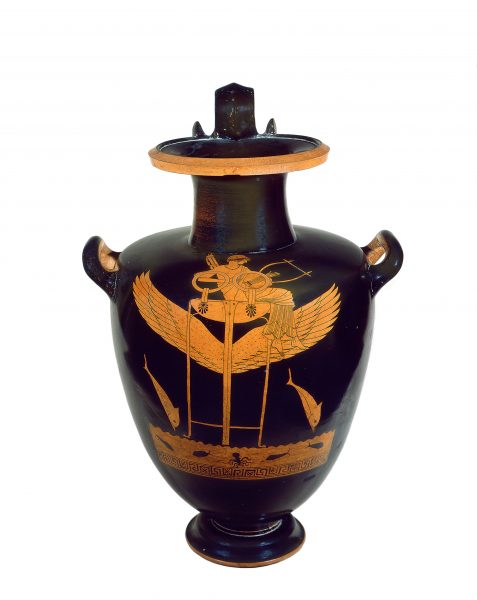
Apollo Seated on a Winged Tripod; Red-figure Hydria of Black-figure shape; ca. 500-490 B.C.
Ebony You mention in your essay in the book that the Berlin Painter popularized the fashion for single unframed figures. Can you say a bit more about that?
Padgett He trained in the Pioneer workshop, the principal red-figure painting atelier in the last quarter of the sixth century. Single figures on each side of the vase were prominent against glossy black backgrounds, and there’s a minimum of ornament. It was all done with clay, of course; the color variations are created with firing differences in the kiln. Even though the figures are on separate sides of the vase, they were understood to share the same conceptual space, and are looking at leach other. The Berlin Painter was an excellent draftsman, and he made the style his own, and popularized it. His influence on other painters of the period was profound.
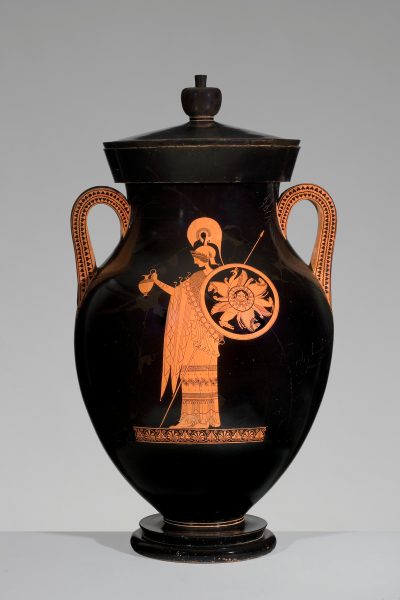
Athena; Red-figure amphora of Type A; ca. 500-490 B. C.
Ebony You also mention that he was rather prim in his subject matter. While he would depict nude males, there is never sexual innuendo, and he never depicts nude females.
Padgett There are no nude women that we know of by him—not even so much as a female breast; and no sex going on among any of the sexes, which is not the case for cups or vases by his contemporaries. He depicts drunken revelers, but they’re just dancing around; they are not interacting that much with one another. He avoids the parties and symposia, and a lot of the sex and violence, including sexual violence that you see in other painters’ works. There are figures of youths and men, sometimes with an air of homoeroticism, but nothing in the least bit overt.
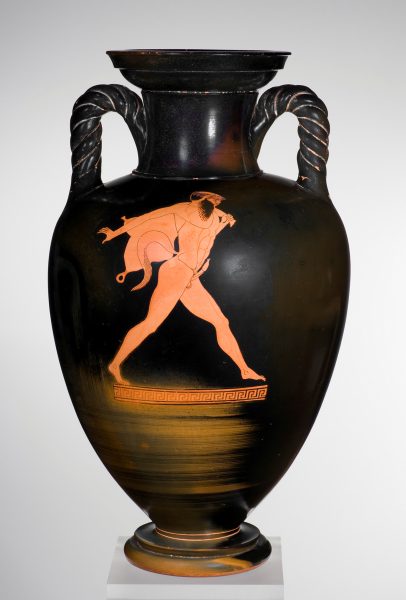
Satyr Carrying a Wineskin; Red-figure Neck-amphora with Twisted Handles; ca. 480 B.C.
Ebony How did you bring this show together? How did it evolve? From a curatorial standpoint, it seems like it would be a very complex and costly venture.
Padgett I pitched the idea to my director [Princeton University Art Museum director James Christen Steward] about three years ago, and he was supportive. I knew that the Berlin Painter as a subject would allow us to focus on ancient Attic painting in general, and other vase painters in this period. But it would also allow us to deal with issues of the methodology of stylistic analysis, connoisseurship, and attributions to individual hands, which has been controversial at times. Some scholars feel that there is too much emphasis placed on Beazley’s approach, and the edifice of scholarship that had been erected around him. We address some of those issues in the book in a chapter by Professor Nathan T. Arrington on connoisseurship and attribution.
Once I got a spot for the exhibition on the museum calendar, I began to make an objects list. We then created loan letters and began negotiating with the various lending institutions, sometimes in person. I went to Berlin, for instance, to make sure that they would lend us the name vase, which I felt was essential.
Ebony It is quite spectacular as the first thing you see when you step into the galleries.
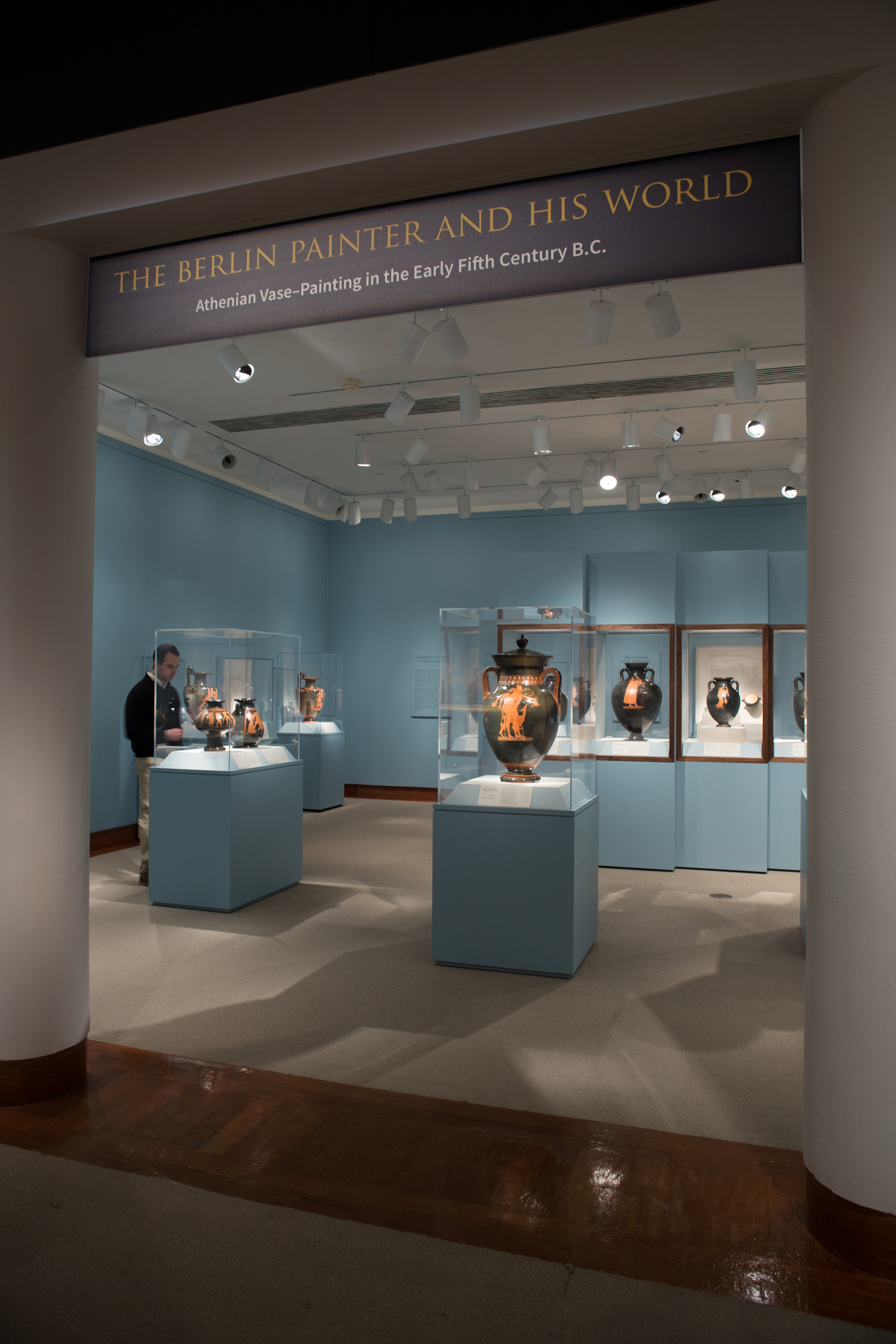
Installation view of The Berlin Painter and His World at the Princeton University Art Museum
Padgett Yes, with Hermes, a satyr and a faun on the front. I also went to Munich, the British Museum in London, Oxford, and met with Carlos Picón at The Metropolitan Museum of Art. It’s important to have a second venue to share some of the costs of an exhibition like this one; and we are honored that the Toledo Museum of Art, which has an outstanding collection of antiquities, will host the exhibition, opening there on July 7.
Ebony Were there any works you would have liked for the show but could not get?
Padgett I had to make some painful decisions about that—about what to ask for, and what to let go. There are great vases by the Berlin Painter in many collections in the United States and in Europe. But the expense of insurance, couriers, and other costs, becomes a factor. It’s most effective to go to institutions that can lend more than one object. It’s better to go to Berlin, where you could get six pieces, or ten from the Louvre, for example. Two works from the Vatican’s collection are the only pieces from Italy.
There are three-hundred and thirty vases currently attributed to the Berlin Painter; we weren’t going to get them all. I wanted a range of shapes, subject matter, and periods. With this in mind, and the quality, I made my list. I included several pieces from Princeton’s own collection to flesh out vase painting in this period.

Eros Riding a Dolphin and Plying the Double Flutes (Auloi); Red-figure Lekythos; ca. 480 B.C.
Ebony The catalogue really matches the ambition and scope of the exhibition.
Padgett Janet Rauscher at the Princeton University Art Museum oversaw production of the catalogue. One important aspect of the publication is a revised catalogue raisonné of the Berlin Painter, building on the list that Beazley made, adding new attributions since then. J. Robert Guy co-edited the catalogue raisonné, which features fragments of vase paintings by the Berlin Painter that are joined together for the first time, at least in the book, with other fragments from the same vase.
Ebony I thought that the closing paragraph in your essay in the book was very poignant in the way you make these ancient paintings relate to our own times. How do you think the Berlin Painter’s art speaks to us today?
Pagett These works, like many Greek vase paintings, appear to be a window on ancient Athenian society. But it’s really a view through a very distorted glass; it’s a construct, a depicted world. There is much that isn’t shown. However, what the Berlin Painter does show us is a sincere non-ironical love of the gods, a reverence for the gods, since they are featured so prominently in his work. We can discern his devotion to the gods through his many images of libations at altars. Some of the subject matter is traditional, but his particular approach involves music, since he depicts many musicians. He may also have been an initiate of the Eleusinian Mysteries, because he often shows devotional images of Demeter and Persephone; and he seems to have an eye for beauty. In that way, he speaks to us directly. Beauty always speaks to us.

Nike at an Altar, Carrying a Phiale and an Oinochoe; Red-figure Lekythos; ca. 480 B.C.
We might like to see ourselves in the Berlin Painter, but we always have to keep him at arm’s length, and understand that his is a foreign world, a distant place. Although we speak of ancient Greece as the ancestor of all of Western civilization, the fact is that Western civilization has many ancestors. That doesn’t matter to me as much as what the Berlin Painter tells us about Athens in the period of the Persian Wars, and about the early years of democracy, and what he tells us about humanity.
David Ebony is currently a Contributing Editor of Art in America magazine. Among his books are Arne Svenson: The Neighbors (2015); Anselm Reyle: Mystic Silver (2012); Carlo Maria Mariani in the 21st Century (2011); Emily Mason (2006); Botero: Abu Ghraib (2006); Craigie Horsfield: Relation (2005); and Graham Sutherland: A Retrospective (1998). He lives and works in New York City.
























